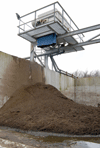NVZ proposals could force stocking rate reductions

Current nitrate vulnerable zone proposals will have a significant impact on most dairy units affected, according to Promar consultant Paul Henman.
Speaking at last week’s Dairy Show, Shepton Mallet, Mr Henman told farmers the proposal to reduce total nitrate limits from 200kg/ha down to 170kg/ha would result in most farms having to reduce stocking rates to some degree.
A typical Promar client’s farm has a herd of 177 cows stocked at about two livestock units a hectare, but to comply with new proposals such a unit would need to cut stocking rate back to 1.86LU/ha – a total reduction of 16 cows, he explained. “Either that or they will need to find other land to export their slurry to in order to reduce nitrate loading on the home unit.”
But exporting slurry could only be done where sufficient storage capacity existed to collect slurry in the first place, warned Mr Henman. “In my experience the average dairy farm has about 10 weeks’ slurry storage, under the proposals this would have to increase to 22 weeks, more than doubling capacity.”
What had to be remembered though was that every farm had different circumstances and there was no blanket answer to the problems faced by different units. “Some farms may choose to export slurry, others may acquire more land and others may cut stock numbers.
“The best thing all units can do is assess each enterprises profitability and where there are livestock which aren’t leaving sufficient profit consider ceasing production, particularly on mixed farms. When, for instance a dairy unit rears beef cross calves it may be that they are better off selling calves and maintaining milking cow numbers to stay within NVZ limits.”
On a practical note, Mr Henman advised farmers to check what currently went into slurry stores and ensure it was only true slurry which was being stored. “Where rainwater is being collected consider ways of diverting it or collecting it. Rainwater could be used for drinking water and help reduce costs there too.
“Gutters and downpipes should be checked to ensure they aren’t leaking on to yards where water will add to slurry store volume and hence reduce the available capacity for true slurry storage. Also field and track run off which heads on to yards could be diverted to ditches before it gets to the yard, saving it from being collected in the slurry store too.”
In more drastic situations and where it was financially viable he suggested it may be worthwhile roofing over open stock yards or silage pits and collecting rainwater to cut down on the volume stored.
Where farms have slurry separators the solid material from these can be treated as farmyard manure, so can be spread at any time of the year provided ground conditions allow, unlike slurry which is subject to closed periods of spreading, explained Mr Henman. “The liquid faction though will have to be treated as slurry.”
But installing a separator could increase storage capacity by as much as 20%, saving on the expense of installing a new store or expanding an existing facility, he added.
